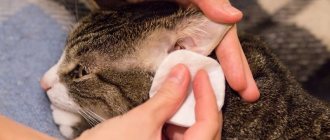When cats hiss at kittens
Watching a cat hissing at kittens, you can notice that often its visible aggression in this case is a kind of lesson. It is not uncommon for babies to be trained in the form of outwardly aggressive play, in which mother and kittens mutually attack each other. In this way, babies gain the skills they need in the future to defend themselves and provide food for themselves.
© shutterstock
When playing, the cat growls, hisses and looks very intimidating, but her aggression is not directed against the kittens, she tries to recreate possible life situations. You should not interfere with their game. If you try to take the cub, the mother may hiss at you. This defense of the kittens by hissing is her natural reaction in the current situation.
How to make friends between a cat and a kitten: ways to reconcile pets
Adult cats are capable of expressing their feelings and character. By its nature, it is a solitary animal, which often finds it difficult to find a common language with other pets and sometimes it is difficult for the owner to make friends between an adult cat and a female cat. This feature of cat behavior should be taken into account if a decision has been made to bring home a new family member - a small kitten. An adult may show aggression towards a kitten. Therefore, it is important to know why this aggression occurs and how to make friends between a cat and a kitten in the future.
Alien smell
Changing the smell of kittens, as a result of our indiscretion in handling babies, can disturb the cat and cause an aggressive reaction in it. A person, holding a kitten in his hands for just a little while, changes its smell. The mother may not recognize him and may even growl at him in order to drive him away. However, as a rule, the mother licks the kitten to return its characteristic smell.
If the cat hisses at the kitten and does not want to accept him, you need to try to return him to the smell familiar to his mother. To do this you can :
- wrap it in your mattress for a while;
- put next to the rest of the kittens;
- rub his fur with mom’s toy.
After some time, the kitten will get rid of the foreign smell and the cat will stop hissing at him and recognize the cub. But it is possible that the mother will reject the baby because of the foreign smell, as if he is not from her offspring. For this reason, it is not recommended to handle small kittens.
Why does an adult cat show aggression towards a kitten that has appeared in the house?
When there is only one pet in the house, a person often has a desire to buy another one.
And then a kitten appears in the family. It would seem that an adult cat, kind and sweet, suddenly becomes aggressive, hisses at the baby and does not accept him at all.
Why is this happening?
First of all, an adult pet perceives a baby as a threat to its comfort, its resources, its quiet existence.
People often think that a cat already knows that she is loved, and with the advent of a second animal she will still be sure of this.
In fact, when a person begins to devote a lot of time to the baby, an adult cat, even if she was not sociable before, feels a shift in attention to the kitten. Moreover, this is not jealousy, this is precisely a lack of attention, a kind of resource that was taken from the cat.
Another factor that interferes with a harmonious relationship can be the difference in energy between a kitten and an adult cat. The kitten is much more active, mobile and he will certainly bore the cat with his attention. Some adult pets do not like intrusion into their personal space; they hiss and get irritated precisely because of this. It can also be difficult for a cat if the kitten is first isolated in a room behind a closed door. Here several irritants appear: a new unfamiliar smell, the closure of part of the cat’s usual territory, the constant movement of a person between these two separated territories. A kitten is not an adult cat that we isolate in order to avoid mutual aggression and to reduce the stress of each pet. A baby requires more attention, but the likelihood of aggression towards an adult cat is low.
What to do for successful mutual adaptation?
Before bringing the kitten home (if it is planned), prepare high surfaces for the cat(s) so that he has his own space where he can take a break from the kitten's activity. When you brought the kitten into the house, simply let him into the new room, give him the opportunity to look around and get acquainted with the territory. Allow the adult cat to sniff the new resident. Even if she hisses, there is no need to immediately intervene and separate the pets. Give them the opportunity to make initial contact. It is possible to separate only in case of signs of clearly demonstrated aggression: the use of claws, teeth, pursuit and attempts to drive into a corner.
Good relations with your cats!
Have your cats accepted another pet right away?
If you are interested in the behavior of cats, I will be glad to see you among the subscribers to my channel!
Source
New pregnancy
In cats, the period between conceptions can be quite short. If she had the opportunity to leave the house, then a second pregnancy is not excluded. Then she will not be able to feed the kittens and will try to get rid of them. Expecting new offspring, the cat will show aggressiveness towards her kittens and will hiss at them in an attempt to drive them away. In this situation, it is necessary to isolate the kittens from their mother and feed them from a pipette or nipple.
© shutterstock
Aggression in a cat: why does it happen?
Cats tend to be possessive, even if they have spent their entire lives sharing a home with other pets. However, if one of the pets takes it to the next level and makes life difficult for the other cat, it's no longer just a game.
Paying close attention to your cat's body language can help identify signs of aggression:
- Gaze.
- Hiss.
- Biting.
- The pursuit.
- Scratch.
- Aggressive stance, arched back, fluffy tail, curled or flattened ears, dilated pupils.
In some cases, the cause of a cat's attack of aggression is obvious: meeting a new cat or other pet, or even the appearance of a newborn baby in the house.
More obvious types of aggression - such as biting, attacking, etc. - often result in physical harm. But aggression is usually aimed at asserting its dominant position, and not at intimidation.
As the American Association of Cat Practitioners notes, “Aggressors can control another animal’s access to food, litter boxes, resting and sleeping areas, and attention from owners, which usually results in isolation of the victim.” If you don't pay close attention, you may not even notice the signs of bullying.
Mature kittens
Cats are very sensitive not only about territory, but also jealously protect their offspring. If the mother shows aggressiveness towards the kittens, then there is a good reason for this :
- She might be sick.
- There is no milk.
- The kittens are already teething and they are causing her pain.
- The kitten is weak, not viable, she does not allow him to have a pacifier so that there is more milk for the rest.
Cats sometimes nurse kittens for up to a year, but most often the maternal instinct lasts for up to six months. After which the mother refuses to feed them, showing that they have already grown up enough and it’s time to cope on their own. You notice that the cat has begun to hiss at her kittens.
No matter how cruel such behavior may seem to a person, it has a good reason. When a cat hisses at her own kittens, this does not mean she is cruel, it’s just that ancient instincts that guide her have awakened in her. You can't punish her for this! A cat's hissing at kittens always has a good reason.
At this moment, the babies must be given to another owner. If you want to keep one of them for yourself, you need to monitor the behavior of your pets, since the mother, emphasizing her primacy in the hierarchy, may be aggressive towards the baby. In this situation, she will not only hiss at the kitten; more aggressive actions are also possible. After a couple of weeks, the cat will calm down, take a position and stop hissing at the kitten.
© shutterstock
Why is a cat aggressive towards her adult kitten and how to make them friends?
QUESTION:
After the last lambing, they kept the cat for themselves, now there are two cats in the apartment - a mother and a daughter, but after she finished feeding, the young one became a stranger to her. They are at enmity, or rather, the mother cat is aggressive towards the young one, hissing and even spreading her paws. They decided to sterilize the eldest one - she is 7 years old, and left the young one for further production of kittens. How can they be reconciled? And when the kittens appear, how will the grandma cat perceive the newborns? Thanks for the answer!
ANSWER:
First of all, you need to decide how serious the conflict is. The fact is that cat games can be very loud and very similar to real battles. The combatants raise their fur, intertwine in embraces, somersault and roll on the floor - however, there is no real aggression or injury. It has been noticed that most of the techniques “rivals” are practiced “with gloves”, without using their claws. After a fight, cats quickly change their anger to mercy and subsequently exist quite peacefully, showing elements of attention and goodwill (mutual licking and rubbing their cheeks, sleeping side by side, eating in close proximity to each other).
Often a hiss, a raised scruff and a strike with a clawed paw are just an expression of a sudden surge of emotion. The animal may have felt irritation or physical discomfort. Group members use this technique to restore the status quo, and an outbreak of aggression does not at all mean a “declaration of war.” It has been noted that quite harsh disputes occur between littermate kittens, but with a significant difference in age, the older animal usually occupies a higher status, supporting it with a demonstration of dominance. There is nothing terrible that a mother periodically “raises” her grown-up daughter, who is entering the phase of puberty - their warm relationship is not broken, but is illustrated by trivial “family scenes.”
The true intensity of the hostility is evidenced by repeated scenes:
- long howls and screams;
- low, angry growls and hisses;
- static “stone” poses;
- ears laid back and pressed to the head;
- looking eye to eye;
- claws extended and readiness to use them;
- raised wool;
- swollen, nervously wriggling tail.
Usually, after a psychological attack, the subordinate individual “loses his nerves” and retreats from the “battlefield.” But rivals of equal strength do not want to give in and, along with intimidation techniques, use alternating pounces and paw strikes. The rash intervention of a frightened owner at such a moment (for example, an attempt to pick up one of the fighters in his arms or push him away with his foot) can “add fuel to the fire”, switching aggression to the person. Need I remind you that “there is no beast worse than a cat,” and an angry cat can cause serious damage in the heat of passion.
The culmination of the confrontation is “close combat”, in which the participants cling together into a single ball using claws and teeth. Shreds of fur flying in all directions, screams and growls add poignancy to the picture.
You can break up such a brutal cat fight using some strong irritant that switches the attention of the animals, for example:
- clap hands;
- the sound of a saucepan lid falling on the floor;
- a sharp shout;
- pouring cold water on the fighters.
Experts advise using another specific trick: you need to throw a blanket or thick blanket over the mating cats, pressing it along the perimeter to the floor, and hold it until the bullies disperse on their own, instinctively clinging to the floor. Next, one of the participants in the battle can be picked up and carried to another room.
Murkas fight for various reasons, but the fights are based on instincts:
- defensive (personal comfort);
- territorial (fight for territory);
- prey (competition for food and other resources);
- sexual (defending the right to have offspring and ensuring their safety);
- social (some kind of “jealousy” towards the owner).
Thus, cats can fight without sharing:
- territory;
- shelters;
- food and toys;
- owner's attention.
In same-sex individuals kept in the same house, “passions” are fueled by sexual cycles.
To level out the conflict and allow both “warring sides” to become more tolerant, felinologists suggest the following actions:
- divide the territory of the house, laying out “its own route” for each pet. Thus, a less aggressive cat can move along the upper tier, for which purpose all kinds of shelves, hammocks, stairs and passages are hung on the walls. Thus, a direct clash “on the warpath” will be excluded. As relations warm up, some of the structures can be removed;
- install at least two trays, houses, beds and scratching posts in different places, which will reduce competition for resources;
- feed cats at the same time, but in different places: for example, one from a bowl on the windowsill, and the other from a bowl on the floor. At the same time, it is important to ensure that the dominant mother does not try to take food from the younger cat;
- pay attention to pets without singling out personalities, trying to stroke or treat both cats with treats from the fingers at once;
- do not ignore the attempts of tailed pets to escalate the conflict, instantly scattering them in different directions;
- for severe anxiety, use sedatives and anti-stress medications (Cat Bayun, Stop Stress, catnip powder).
Steilization leads to a decrease in the level of sex hormones and often to an automatic decrease in the personal status of the animal. After surgery, the cat becomes less frisky and emotional, which will most likely reduce its bullying behavior.
It is impossible to predict the attitude towards future kittens born by a cat-daughter: with a developed maternal instinct, the “grandmother” will treat her “grandchildren” with love and care, helping her daughter cope with her offspring. But a less successful scenario is also possible, when the older animal perceives newborns as increased pressure. Some lovers of mustachioed tabby cats write that as the second individual grows up, the slaughter intensifies and one of the cats has to be handed over to “good hands.”
Tweet
How to distinguish a fight in a game from a real conflict?
Many cats that have a close bond enjoy playing together. They fight, rush around the apartment, roll around in a ball and hit each other with their paws. Play wrestling often takes place silently with breaks during which the participants change positions. Such fights do not bring pain, because... the animals retract their claws and strike carefully. At this stage there is no need to separate the pets. In some cases the struggle may intensify; Hissing and squealing indicate that the animal’s partner’s actions are beginning to cause discomfort. After joint activity, the cats quickly return to their normal state, and there is no tension in further relationships between the participants in the play fight.
How to help animals make friends
How to make friends between a cat and a dog: options for reconciling pets
How to make friends between a cat and a kitten without stress and hurting each other? Friendship between an adult cat and a kitten is a matter of time. The result of their meeting and long-term hostility may be unexpected.
Sometimes the cat immediately accepts the kitten as if it were her own baby and comes to its defense. A cat may show sexual attraction to him if the owner has not resorted to castration.
But most often, without human help, friendship or at least acceptance does not arise. Therefore, the owner of an adult animal should learn simple reconciliation techniques and stock up on good patience. You can learn from your own experience how to introduce a cat to a kitten.
The process is gradual and consists of several steps:
- Maintaining personal space.
- Accustoming a kitten to its litter box and bowl.
- Sniffing at first meeting.
- Cooperative games.
- Gradually bringing bowls closer together during meals.
- Equal attention from the owner to all pets in the house.
A cat's first reaction to a strange kitten is hissing.
Personal space
First of all, a cat perceives a small cat as a contender for their territory. The owner's job is to change this perception.
The animal must realize that the kitten is not an invader and does not claim its space. During the first days, the baby should be isolated in another room and not allowed to cross paths with the cat. The kitten must be provided with its own bowl, bed and tray.
Attention! Many adult pets abandon their usual litter boxes and begin to relieve themselves throughout the apartment if their toilet has been marked by someone else's animal.
After a few days, when the cat has learned to eat from her bowl, go to her litter box and sleep on her bed, she can be released into the common room for a short time. This will begin the gradual acquaintance of the pets, which will be the first step towards their living together.
Acquaintance
The first acquaintance of animals occurs through smells. Even a kitten locked in another room is perfectly felt by a cat. The newcomer emits odors that are keenly detected by other pets. The cat will come to the door, sniff it, and maybe even ask to go into that room.
In such a situation, it is better to ignore her meowing and not let her into the room with the kitten. This can result in attack and aggression. After a few days, the cat will get used to the new smell, which will help the personal acquaintance be more calm and restrained.
The cat first sniffs the kitten for a long time, then can accept it
The first meeting between a kitten and an adult animal should take place under the control of the owners. It is possible that there may be a manifestation of temperament and an unpredictable reaction to the baby. Sometimes the meeting ends with curiosity and friendliness. But most often the kitten is faced with indifference or aggression. The owner must be alert and have time to protect the baby.
My cats suddenly started fighting. What should I do?
If cat aggression results in a fight, the best solution is to separate the animals and place them in different rooms for 1-2 days until they calm down. Repeating active hostilities at the next encounter will require separating the pets for a longer period. In this situation, cats should be perceived as strangers seeing each other for the first time.
Sometimes manifestations of aggression happen at the most inopportune time, when a person is not ready for sudden conflicts. For example, a group of animals may react negatively to the return of a cat that has undergone surgery at the veterinary clinic.
Communication in the cat community is carried out primarily through smell; With their help, animals separate their own from strangers. From the clinic, the cat brings with it a mixture of unpleasant and even threatening “odors.” This misleads the members of her “group”, who are unable to recognize the cat as a companion. To avoid hostility in the cat family, an animal that has been to the veterinarian should be isolated in a separate room for at least 12 hours (or overnight). This time should be enough for the pet to lick the fur and “return its native scent.” By stroking and showing your love in every possible way, you can help the cat stabilize its emotional state, but it is important to be careful when handling the operated animal. It would be a good idea to get care instructions from your veterinarian.
The cat is just tired
Your mother cat “works” around the clock, taking care of all her babies, feeding them, making them go to the toilet, washing them and teaching them how to use the litter box. She was just terribly tired!
The moment the cat starts hissing, she is telling her young children, “Hey, I need a few minutes of me time. Take a nap or go play. Now!" This is normal behavior and does not mean that babies need to be separated from their mother. If the owner tries to do this, he will certainly receive several painful scratches for his actions.
My pet is being attacked by the cat living next door. What can I do?
Sometimes aggression associated with the manifestation of territorial rights goes beyond what is necessary. The so-called hooligan cats deliberately appear on “foreign land” in order to claim it. They enter properties and houses, attacking furry residents (and sometimes their owners if they become an obstacle), and also mark vertical surfaces before leaving. These impudent people rarely encounter resistance on their way, because... choose the victim wisely - an older, weaker or timid cat. Interestingly, in the UK the largest number of “criminals” are found among pets of the Burmese and Bengal breeds. However, aggressive behavior associated with invading someone else's territory can be exhibited by any cat (this is more typical for males), no matter whether they are purebred or not.
It is very unpleasant when your cat is attacked in her own home. There is a desire to demand that the owner of the “shaggy insolent” take action to prevent future attacks, since it is he who is responsible for his robber. However, the reality is that the owner of an abused cat often has to take matters into his own hands. If a furry friend is unable to stop the attack, a person should intervene to protect the pet and its territorial rights.
There is debate as to whether the intrusion of some individuals into someone else's space is considered normal. At the moment, there is no evidence that attacks on relatives for territory are something unnatural for representatives of the cat family.
Both purebred and street cats have been living next to each other for many generations. It would seem that it is time for them to moderate their territorial appetites. However, natural cat aggression has not disappeared. It’s just that a significant portion of individuals exhibit it to a lesser extent.
When faced with a furry aggressor, you must first determine whether it has an owner. If a cat lives on the street, you need to contact employees of a specialized service who humanely catch, castrate and rehome the animals.
If the owner is identified, you need to try to negotiate with him about the “confinement” of the despot at night within the walls of the house (if the invasion occurs in the dark). To motivate an aggressive animal to return from a walk at the appointed time, the owner can treat him with some kind of treat before bed. A cat that goes on “raids” during the day may be subject to a curfew. If other pets suffer from his aggressive behavior, it is necessary to inform their owners about the restrictive measures introduced; owners will know that during this period of the day their animals are not in danger. It would also be useful to attach bells to the collar of the aggressor cat, the ringing of which will warn of the approach of the bully and will enable pets and owners to take the necessary measures.
To make an attacked cat feel calmer, you should “tightly” close the cat flap, as well as other passages that allow a stranger to enter the house. An additional safety measure will be to calculate the route of an aggressive cat and block the path. A prey cat, even one accustomed to going outside, must be provided with a home litter box. When a suffering furry friend leaves the premises, it is best to accompany him. If the cat is accustomed to using its own entrance/exit and insists on free movement, you can use modern technologies and install a special damper “customized” for the resident of the house. However, some sneaky people who want to get into other people's houses manage to fool such devices.
The owner of an aggressive cat, in addition to confining his pet, should take additional measures. Restrictions on movement can cause stress in an animal, so it is necessary to create an atmosphere conducive to relieving emotional stress: place several soft and warm loungers around the house, as well as arrange play sessions in the morning, evening, and during those periods when the bully is usually overly active.
For some cats, aggressive behavior is so deeply ingrained in nature that the only solution may be to move to an area with fewer cats.
My pet bit someone else's cat. Do I have to pay for treatment?
Although aggression is normal among felines, serious incidents can lead to disputes between cat owners (especially if the aggressor attacks multiple animals). Sometimes the showdown gets so bad that police intervention is required. At the legislative level, each country solves this problem in its own way. In the UK, for example, there are precedents for assigning sums of money that owners of tyrannical cats had to pay to the injured party as damages.
Based on materials from icatcare.org
Weaning time
All little kittens grow into big beautiful cats. But sometimes they lose sight of the fact that it is time to move away from their mother. She is tired of feeding her children 24/7. Ultimately, she wants to expand her horizons and spend more time by herself, lounging in her favorite chair and dozing all day long. Therefore, the mother cat may hiss and growl to calm herself down a little. When it's time to wean—usually around 6 weeks after giving birth—the cat will let her babies know through this behavior.











